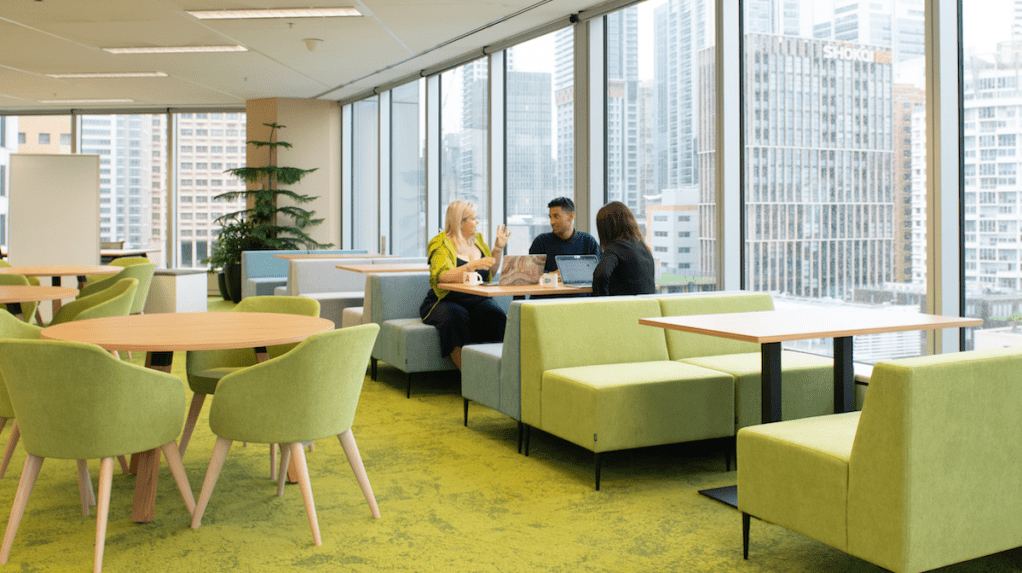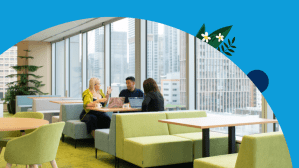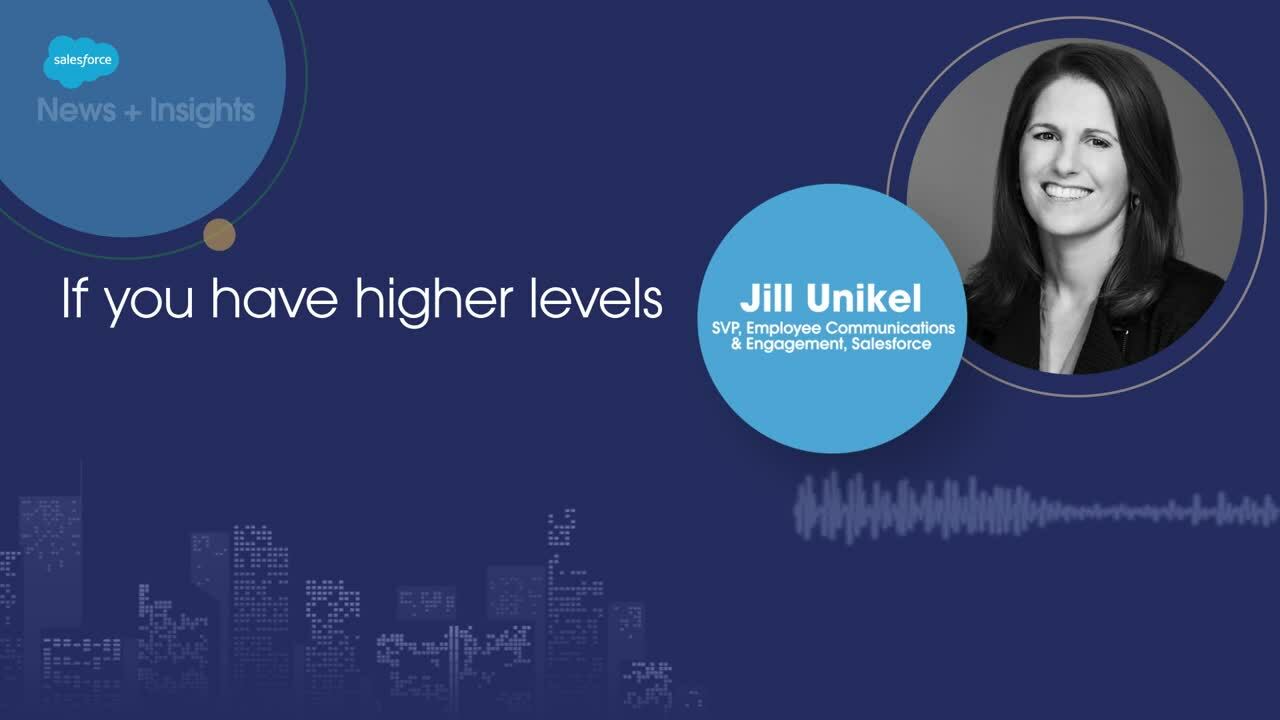As the world begins to reopen, Salesforce shares how it is approaching the future of the office, the technology that facilitates hybrid work, and how putting employees at the center of the equation will create success from anywhere.
“Let’s meet in my office in 10.”
Today, these conversations look and feel entirely different. After a massive step into the unknown moved most workforces remote overnight, employees now receive requests like these via technologies Salesforce calls Cloud 3.0 – Slack, Zoom, Chat, AI, and IoT.
While many employees now enjoy the flexibility of working from anywhere, many also crave face-to-face connection. Hallway conversations, coffee breaks, and team happy hours are happening virtually. And with the employees’ primary hub for connection – the office – not yet part of the daily routine, the employee experience has completely changed. If companies aren’t intentional about bringing people together, it can impact both employee engagement and productivity.
“Research is showing connection is something people are craving in this type of environment,” said Jill Unikel, SVP, Employee Communications & Engagement, Salesforce. “Companies and leaders are adapting and exploring different ways to create human connection and provide relevant, engaging employee experiences.”
The onus now falls to companies to provide the right environment, technology, coaching, and support to keep employees happy and engaged. It’s something leaders at Salesforce remain hyper-focused on — both in ensuring employees feel connected, and helping customers support their employees too.
Using data to design the workplace of the future
Salesforce introduced wellbeing surveys early on in the pandemic to help understand employee sentiment around core challenges posed by COVID-19 — from evaluating feelings of burnout and stress to how employees feel about returning to the office. These surveys have guided Salesforce’s re-opening strategy, and helped plan for what the future office would look like.
Survey data revealed nearly half of employees only wanted to come in as little as a few times per month, but that 80% are still hungry for the connection, camaraderie and innovation that comes from gathering in- person.
Guided by employee feedback, Salesforce introduced its new workplace model – offering teams three ways of working: flex (1-3 days in the office per week on average), fully remote and office-based.
Surveys also showed that hybrid workers want the option of the office, but they want to be purposeful when they use it. The expectation is it will be used for collaborative work and meetings — in addition to connecting with colleagues and experiencing company culture.
This is why Salesforce workspaces are being redesigned with more social and breakout spaces to foster human connection and collaboration.

“People are going to be purposeful in how they use the office moving forward, and our surveys tell us what we need the office to be for all our employees,” said Michele Schneider, SVP Global Workplace Services, Salesforce. “Thinking about the technology needed and the design needed for increased face-to-face meetings and collaboration, the office needs to support our teams and help our employees’ career development.”
When Salesforce leaders started to think about operationalizing this, one challenge they knew they had to solve was capacity planning. Moving from a majority 80% in-office employee base, to an employee base coming in 1-3 days a week, with their team, for specific projects, means an added layer of complexity as it comes to figuring out precisely where teams will work in the office, and how to utilize space in such a way that makes the office feel alive.
Work.com, Salesforce’s suite of products for the new hybrid work world, helps companies make data-driven decisions for shift scheduling, capacity management and hybrid and office-based employee planning. Leveraging real-time data, companies can create a flexible framework to utilize their spaces and operate safely and efficiently.
Siemens and Salesforce were the first to deploy the new solutions in their own offices, including Siemens Smart Infrastructure headquarters in Zug, Switzerland, and Salesforce Tower San Francisco.
Salesforce is focused on creating an in-office environment that sparks creativity and productivity for employees, says Schneider. “We want employees to feel that energy, that buzz going on, because more folks will be in-office,” said Schneider. “How do we utilize space more efficiently and effectively so that employees feel productive when they’re in the space?”
“How do we utilize space more efficiently and effectively so that employees feel productive when they’re in the space?“
Michele Schneider, SVP, Real Estate and Workplace Services, Salesforce
Tools that power employee engagement
Although the tools exist to enable work from anywhere, many companies aren’t set up to deliver them.
Explained Unikel, “the pandemic has exacerbated the disconnect between technologies we use as consumers, and technologies we use as employees. We all have these cloud, social, mobile-connected experiences in our personal lives — where everything can be done from our phones and your technology knows exactly who you are. Companies have not been providing that experience when you go to work, and have left internal systems behind.”
Salesforce started with its 60,000 employees as “customer zero,” and focused on ensuring they had the tools at their fingertips to be successful from home — including productivity and engagement tools like Work.com, communication tools like Slack and Zoom, a centralized hub for employees to access apps in one place, and an increased frequency of company communications — from weekly all-hands calls hosted by executive leadership, to a daily email Newsletter branded “The Daily” with everything employees need to know.
“When we provide employees with personalized cloud, social and mobile-connected experiences, it’s a huge engagement driver,” said Unikel. “There’s the business case that it helps teams and employees perform their jobs more effectively, but the bonus really comes from employees being more motivated and engaged, leading to even more productivity.”
To create these consumer-like tools and experiences for employees, Salesforce turned to its Customer 360 offering and applied it internally — making Customer 360 the platform for Employee Success teams.
By layering Salesforce on top of our systems of record, added Unikel, we’re able to deliver a best-in-class employee experience, amping up productivity and engagement.
With remote and hybrid work here to stay, Salesforce wanted to help its customers help their employees succeed from anywhere. Since launching Work.com last year, Salesforce expanded its offerings to focus more broadly on employee experience, with products that increase productivity, engagement, and deliver IT support. Employee Workspace, for example, acts as an employee’s digital desk — giving them a single, connected space to access the apps, resources and information they need to work productively and connect with colleagues.
“Every employee experience is now a technology experience,” said Joe Ryan, SVP of Product Management, Salesforce. “We have a unique opportunity to rethink how we deliver employee experiences.”
Employees’ new favorite colleagues: AI and automation
2020 accelerated the digital transformation and changed the landscape of work forever. Now, companies will need to find more ways for employees to excel in this new work environment.
AI and automation is changing the employee experience and companies are in the early stages of realizing its potential.
“Automation frees up people to be creative and curious, especially when combined with highly personalized insights and recommendations surfaced from AI,” said Brian Solis, Global Innovation Evangelist, Salesforce.
“Automation frees up people to be creative and curious, especially when combined with highly personalized insights and recommendations surfaced from AI.”
Brian Solis, Global Innovation Evangelist, Salesforce
One internal team at Salesforce that heavily relies on automation is Employee Success, specifically when it comes to hiring and onboarding in the midst of a pandemic.
“Automation plays a huge role in allowing our Employee Success teams to focus on the more personal touches that make our new team members feel like a full part of our Ohana,” said Jo-ann Olsovsky, CIO, Salesforce. “By automating some of the repetitive administrative tasks that come with every new hire — such as communicating to new employees what internal resources are available to them and what onboarding tasks need to be completed — our IT teams were able to efficiently provision new employees with the equipment they needed while HR teams were able to easily onboard them.”
The benefits of automation and AI that support employees through the pandemic spans industries and use cases. Take service — an industry historically defined by hundreds of agents sitting side by side in a call center. In a pandemic-induced virtual environment, agents are managing increased customer demand and frustration over service. As a result, thousands of companies are turning to AI-powered chatbots to improve customer service and accommodate increased demand — many using Salesforce’s Service Cloud.
“With today’s hybrid work world, our customers look to us to power their businesses with new capabilities – digital channels, self-service portals, Einstein Bots, agent workflow and routing – to service their customers, said Clara Shih, CEO of Service Cloud, Salesforce.
In fact, the millions of Americans in contact centers, retail locations, or serving as field technicians now find themselves in hybrid roles — from customer service agents who work from home, to field service technicians servicing virtually over video. Most work on shifts, and even prior to the pandemic, organizations struggled with spreadsheets and legacy systems for shift scheduling and capacity planning. The suddenly remote and hybrid environment has only exacerbated the difficulty.
Salesforce created Service Cloud Workforce Engagement as a way to help these companies provide modern, AI-powered experiences for contact centers — giving agents transparent scheduling, real-time coaching and personalized training to succeed from anywhere. Service Cloud Voice provides real-time transcription and Einstein recommendations so that agents get the support they need, and managers have insight into how they can help.
These tools and technologies will go a long way for companies looking toward the reopening of society.
“Salesforce’s vision for workforce management will allow us to balance efficiency goals with our people and culture goals, which prioritizes celebrating agent skills and providing an engaging place to interact with their workday,” said Nigel Piper, Executive General Manager, Xero, a Salesforce customer.
The benefit of this is a better employee experience.
“Not only are you optimizing business processes to deliver a new standard for customer experience, but you’re also freeing up creative human resources to do more meaningful work,” said Solis.
“Not only are you optimizing business processes to deliver a new standard for customer experience, but you’re also freeing up creative human resources to do more meaningful work.”
Brian Solis, Global Innovation Evangelist, Salesforce
Putting the employee first
Rapidly changing priorities, shifting work environments and new technology puts a strain on employees — on top of the tower of personal commitments brought on by the pandemic.
“The pandemic brought to life the importance of our employees’ mental wellbeing,” said Simon Mulcahy, Chief Innovation Officer, Salesforce. “Their needs hadn’t changed, but it increased our understanding of expectations and behaviors, and the pressure people have been under for so long, now combined with even greater pressures at home.”
Creating and maintaining a work-life balance is key to ensuring employees can be successful in whatever their future work environment looks like.
As Salesforce begins its reopening strategy, putting employee wellbeing at the forefront remains top of mind, and is something that a more flexible work style may actually aid.
In Salesforce’s Sydney office — which has been safely open since August 2020 — employee survey feedback results are promising: Employees are 16% more likely to agree they are more productive at home, and 13% more likely to agree that their teams are more productive at home than in the office. And they have more balance while they do it — 20% of employees at home are more likely to integrate wellbeing breaks into their day than employees in the office.
What’s next for employee engagement
Technology will continue to evolve, but viewing it from an employee and connectivity lens should take priority.
“The fastest way to get your customers to love your brand is to get your employees to love their job,” said Tiffani Bova, Growth Evangelist, Salesforce. “They feel safe. They feel empowered. They feel they have the tools that they need.”
According to Salesforce, when employees feel connected to their workplace, 62% say their work positively impacts their health, and organizations with high employee engagement have 22% higher productivity.
“For companies planning for the future, the biggest advice we can give is to experiment,” said Matt Artz, Vice President, Work from Anywhere, Salesforce. “Companies should ask themselves: What are our core beliefs as a company, and have they changed in the last year? How might they change in the future? What experiments can we run to test these hypotheses, and how can we gather feedback from our employees to see what’s working?”
To secure positive employee engagement: aligned expectations, a flexible workplace, connected technologies, and coaching and support, is a great place to start.
“The definition of happiness is individual, yet the collective happiness of a company has the ability to make or break a business,” said Bova.
Read more about Salesforce’s reopening strategy here.
Forward-Looking Statements
This communication may relate to a proposed business combination transaction between salesforce.com, inc. (“Salesforce”) and Slack Technologies, Inc. (“Slack”). This communication includes forward-looking statements within the meaning of Section 27A of the Securities Act of 1933 and Section 21E of the Securities Exchange Act of 1934. Forward-looking statements relate to future events and anticipated results of operations, business strategies, the anticipated benefits of the proposed transaction, the anticipated impact of the proposed transaction on the combined company’s business and future financial and operating results, the expected amount and timing of synergies from the proposed transaction, the anticipated closing date for the proposed transaction and other aspects of our operations or operating results. These forward-looking statements generally can be identified by phrases such as “will,” “expects,” “anticipates,” “foresees,” “forecasts,” “estimates” or other words or phrases of similar import. It is uncertain whether any of the events anticipated by the forward-looking statements will transpire or occur, or if any of them do, what impact they will have on the results of operations and financial condition of the combined companies or the price of Salesforce’s or Slack’s stock. These forward-looking statements involve certain risks and uncertainties, many of which are beyond the parties’ control, that could cause actual results to differ materially from those indicated in such forward-looking statements, including but not limited to: the impact of public health crises, such as pandemics (including coronavirus (COVID-19)) and epidemics and any related company or government policies and actions to protect the health and safety of individuals or government policies or actions to maintain the functioning of national or global economies and markets; the effect of the announcement of the merger on the ability of Salesforce or Slack to retain and hire key personnel and maintain relationships with customers, suppliers and others with whom Salesforce or Slack do business, or on Salesforce’s or Slack’s operating results and business generally; risks that the merger disrupts current plans and operations and the potential difficulties in employee retention as a result of the merger; the outcome of any legal proceedings related to the merger; the ability of the parties to consummate the proposed transaction on a timely basis or at all; the satisfaction of the conditions precedent to consummation of the proposed transaction, including the ability to secure regulatory approvals on the terms expected, at all or in a timely manner; the ability of Salesforce to successfully integrate Slack’s operations; the ability of Salesforce to implement its plans, forecasts and other expectations with respect to Salesforce’s business after the completion of the transaction and realize expected synergies; and business disruption following the merger. These risks, as well as other risks related to the proposed transaction, are included in the registration statement on Form S-4 (as amended, the “Registration Statement”) that was filed by Salesforce with the Securities and Exchange Commission (“SEC”) and declared effective by the SEC on January 29, 2021, the prospectus that was filed by Salesforce with the SEC on January 29, 2021 (the “Prospectus”) and the definitive proxy statement that was filed by Slack with the SEC on January 29, 2021 (the “Proxy Statement”). While the list of factors presented here is, and the list of factors presented in the Registration Statement, Prospectus or Proxy Statement are, considered representative, no such list should be considered to be a complete statement of all potential risks and uncertainties. For additional information about other factors that could cause actual results to differ materially from those described in the forward-looking statements, please refer to Salesforce’s and Slack’s respective periodic reports and other filings with the SEC, including the risk factors identified in Salesforce’s and Slack’s most recent Quarterly Reports on Form 10-Q and Annual Reports on Form 10-K. The forward-looking statements included in this communication are made only as of the date hereof. Neither Salesforce nor Slack undertakes any obligation to update any forward-looking statements to reflect subsequent events or circumstances, except as required by law.
No Offer or Solicitation
This communication is not intended to and shall not constitute an offer to buy or sell or the solicitation of an offer to buy or sell any securities, nor shall there be any sale of securities in any jurisdiction in which such offer, solicitation or sale would be unlawful prior to registration or qualification under the securities laws of any such jurisdiction. No offering of securities shall be made, except by means of a prospectus meeting the requirements of Section 10 of the U.S. Securities Act of 1933, as amended.
Additional Information about the Merger and Where to Find It
In connection with the proposed transaction, Salesforce filed with the SEC the Registration Statement and the Prospectus, and Slack filed with the SEC the Proxy Statement. The Registration was declared effective on January 29, 2021 and the Prospectus and the Proxy Statement were first mailed to shareholders of Slack on or about January 29, 2021. Each of Salesforce and Slack may also file other relevant documents with the SEC regarding the proposed transaction. The information in the Prospectus and Proxy Statement may be changed. This document is not a substitute for the Registration Statement, the Prospectus and the Proxy Statement or any other document that Salesforce or Slack may file with the SEC. INVESTORS AND SECURITY HOLDERS ARE URGED TO READ THE REGISTRATION STATEMENT, THE PROSPECTUS AND THE PROXY STATEMENT AND ANY OTHER RELEVANT DOCUMENTS THAT MAY BE FILED WITH THE SEC, AS WELL AS ANY AMENDMENTS OR SUPPLEMENTS TO THESE DOCUMENTS, CAREFULLY AND IN THEIR ENTIRETY BECAUSE THEY CONTAIN OR WILL CONTAIN IMPORTANT INFORMATION ABOUT THE PROPOSED TRANSACTION. Investors and security holders are able to obtain free copies of the Registration Statement, the Prospectus and the Proxy Statement and all other documents containing important information about Salesforce, Slack and the proposed transaction, once such documents are filed with the SEC, through the website maintained by the SEC at http://www.sec.gov. Copies of the documents filed with the SEC by Salesforce may be obtained free of charge on Salesforce’s website at http://www.salesforce.com/investor or by contacting Salesforce’s Investor Relations department at investor@salesforce.com. Copies of the documents filed with the SEC by Slack may be obtained free of charge on Slack’s website at investor.slackhq.com or by contacting Slack’s Investor Relations department at ir@slack.com.























